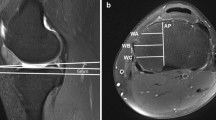Abstract
Background
Recreation of near normal posterior tibial slope is required for proper knee biomechanics after unicondylar as well as total knee arthroplasties. It is also required for proper functioning of anterior cruciate ligament after high tibial osteotomies. Researchers have found differences in values of posterior tibial slopes in individuals of different ethnicities. So far there is no study measuring the posterior slopes of medial and lateral tibial plateau separately in knees of healthy Indian population via three dimensional imaging modalities like computed tomography.
Aim
The aim of our study is to find out the slopes of medial and lateral tibial plateau separately through computed tomography (CT) scans.
Materials and Methods
CT-based measurements of posterior tibial slopes were done in 62 healthy knees. There were 55 males and 7 females.
Results
Age groups were in the range of 17–45 years. Mean values of Posterior tibial slope of medial and lateral tibial plateau for combined sample were 8.60° ± 3.51° and 7.94° ± 3.91°. Mean values of medial and lateral tibial plateau for males were 8.33° ± 3.51° and 7.71° ± 4.07° respectively; while for females were 10.69° ± 2.86° and 9.77° ± 1.32°, respectively.In our study, there was a large range of slopes, extending from + 0.6° to 15.6° for medial tibial slope, from 0° to 15° for lateral tibial slope
Conclusion
The minimum values of Medial tibial plateau slope are very low as compared to the previous study done in Asian population. Further CT based studies are required to measure values of posterior tibial slope for larger sample from Indian population. The implant design suitable and their implantation guidelines for western population may not be appropriate for Indian population.



Similar content being viewed by others
References
Utzschneider, S., Goettinger, M., Weber, P., Horng, A., Glaser, C., Jansson, V., et al. (2011). Development and validation of a new method for the radiologic measurement of the tibial slope. Knee Surgery, Sports Traumatology, Arthroscopy, 10, 1643–1648.
Agneskirchner, J. D., Hurschler, C., Stukenborg-Colsman, C., Imhoff, A. B., & Lobenhoffer, P. (2004). Effect of high tibial flexion osteotomy on cartilage pressure and joint kinematics: a biomechanical study in human cadaveric knees. Winner of the AGA-DonJoy Award. Archives of Orthopaedic and Trauma Surgery, 124(9), 575–584.
Lombardi, A. V., Jr., Berend, K. R., Aziz-Jacobo, J., & Davis, M. B. (2008). Balancing the flexion gap: relationship between tibial slope and posterior cruciate ligament release and correlation with range of motion. Journal of Bone and Joint Surgery, 90(Suppl 4), 121–132.
Dejour, H., & Bonnin, M. (1994). Tibial translation after anterior cruciate ligament rupture Two radiological tests compared. Journal of Bone and Joint Surgery, 76(5), 745–749.
Hashemi, J., Chandrasekhar, N., Gill, B., et al. (2008). The geometry of the tibial plateau and its influence on the biomechanics of the tibiofemoral joint. Journal of Bone and Joint Surgery, 90-A, 2724–2734.
Hudek, R., Schmutz, S., Regenfelder, F., Fuchs, B., & Koch, P. (2009). Novel measurement technique of the tibial slope on conventional MRI. Clinical Orthopaedics and Related Research, 467(8), 2066–2072.
Haddad, B., Konan, S., Mannan, K., & Scott, G. (2012). Evaluation of the posterior tibial slope on MR images in different population groups using the tibial proximal anatomical axis. Acta Orthopaedica Belgica, 78(6), 757–763.
Stijak, L., Herzog, R. F., & Schai, P. (2008). Is there an influence of the tibial slope of the lateral condyle on the ACL lesion? A case-controls study. Knee Surgery, Sports Traumatology, Arthroscopy, 16, 112–117.
Matsuda, S., Miura, H., Nagamine, R., Urabe, K., Ikenoue, T., Okazaki, K., & Iwamoto, Y. (1999). Posterior tibial slope in the normal and varus knee. American Journal of Knee Surgery, 12, 165–168.
Genin, P., Weill, G., & Julliard, R. (1993). The tibial slope. Proposal for a measurement method. Journal of Radiology, 74(27), 33. French.
Hernigou, P., & Deschamps, G. (2004). Posterior slope of the tibial implant and the outcome of unicompartmental knee arthroplasty. The Journal of Bone and Joint Surgery, 86-A(3), 506–511.
Shelburne, K. B., Kim, H. J., Sterett, W. I., & Pandy, M. G. (2011). Effect of posterior tibial slope on knee biomechanics during functional activity. Journal of Orthopaedic Research, 29(2), 223–231.
Bellemans, J., Robijns, F., Duerinckx, J., Banks, S., & Vandenneucker, H. (2005). The influence of tibial slope on maximal flexion after total knee arthroplasty. Knee Surgery, Sports Traumatology, Arthroscopy, 13(3), 193–196.
Kessler, M. A., Burkart, A., Martinek, V., & Beer, A. (2003). Imhoff Development of a 3-dimensional method to determine the tibial slope with multislice-CT] [in German]. Zeitschrift fur Orthopadie und ihre Grenzgebiete, 141, 143–147.
Faschingbauer, M., Sgroi, M., Juchems, M., Reichel, H., & Kappe, T. (2014). Can the tibial slope be measured on lateral knee radiographs? Knee Surgery, Sports Traumatology, Arthroscopy, 22, 3163–3167.
Brazier, J., Migaud, H., Gougeon, F., Cotten, A., Fontaine, C., & Duquennoy, A. (1996). Evaluation of methods for radiographic measurement of the tibial slope: A study of 83 healthy knees. Revue de Chirurgie Orthopedique et Reparatrice de l’Appareil Moteur, 82(3), 195–200.
Lipps, D. B., Wilson, A. M., Ashton-Miller, J. A., & Wojtys, E. M. (2012). Evaluation of different methods for measuring lateral tibial slope using magnetic resonance imaging. The American Journal of Sports Medicine., 40(12), 2731–2736.
Dejour, H., & Bonnin, M. (1994). Tibial translation after anterior cruciate ligament rupture. Two radiological tests compared. The Journal of Bone and Joint Surgery, 76, 745–749.
Funding
None.
Author information
Authors and Affiliations
Corresponding author
Ethics declarations
Conflict of Interest
The authors declare that they have no conflict of interest.
Ethical Standard Statement
This article does not contain any studies with human or animal subjects performed by the any of the authors.
Informed Consent
For this type of study informed consent is not required.
Additional information
Publisher's Note
Springer Nature remains neutral with regard to jurisdictional claims in published maps and institutional affiliations.
Rights and permissions
About this article
Cite this article
Kumar, P., Gupta, A.K. Measurement of Posterior Tibial Slope in Healthy Indian Population: A CT-Based Study. JOIO 56, 1547–1553 (2022). https://doi.org/10.1007/s43465-022-00647-y
Received:
Accepted:
Published:
Issue Date:
DOI: https://doi.org/10.1007/s43465-022-00647-y




